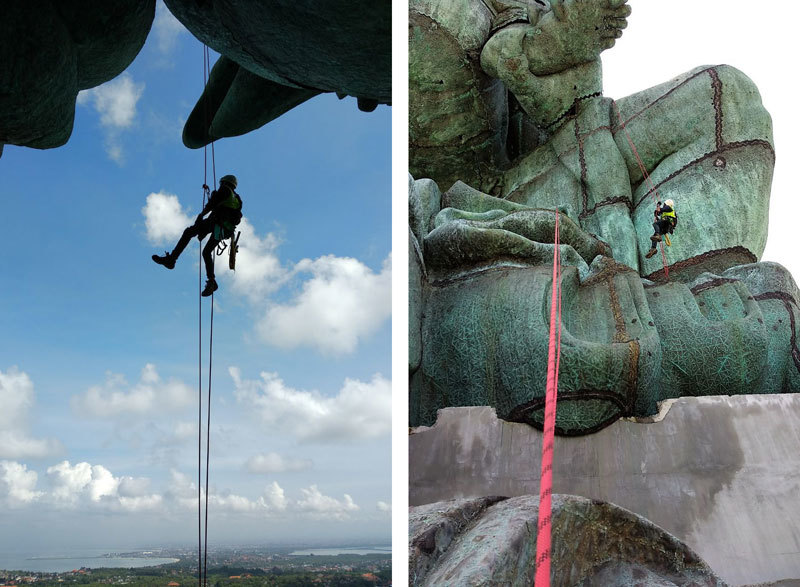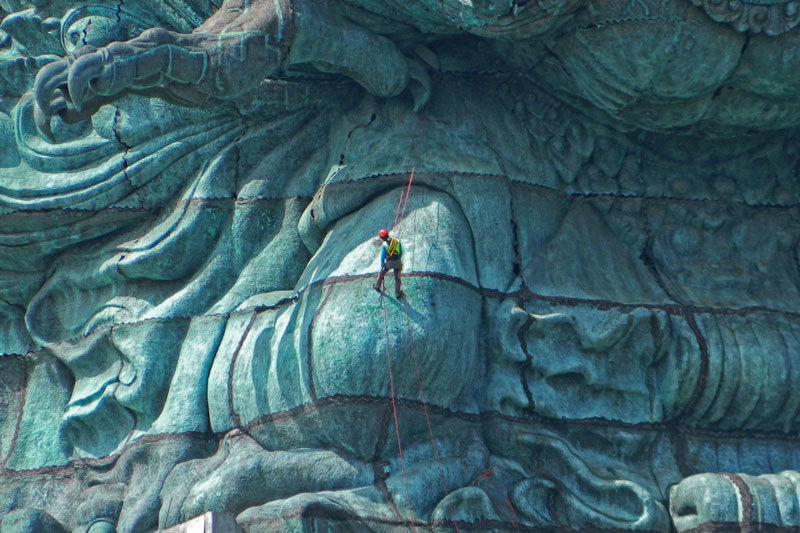The statue of Garuda Wisnu Kencana (GWK)—which honours the Hindu God Vishnu and the mythical bird, Garuda, believed to be his companion—will be unveiled at GWK Park in Ungasan, Bali, this month. NOW! Jakarta spoke to the designer, I Nyoman Nuarta, about the process.

The statue will be officially inaugurated this month. Is there a reason why you chose August?
I looked at the state’s calendar of events and noticed there were many important events held in August, like the Asian Games and the registration of presidential candidates. So, I had to choose the right date in August. I planned to finish construction by the end of July and unveil it in August. For me, August is the right time because I want the statue to become part of the country’s history—and a gift for Indonesia’s 73rd Independence Day.
Can you tell us about the process of designing the statue?
There were many problems. The statue contains not only elements of art,but also technology and science. I used magnifying scales and pattern segmentation which I discovered around the 1980s. This is a large statue and no one has ever created a statue using scale enlargement technology. Without making a sample, it took shape and we saw the result directly.
The unique process was that we cooperated with experts from different disciplines. I brought the mock-up to the aerodynamic experts and tested it in a wind tunnel in Canada where we calculated the maximum velocity of the wind that may hit the statue. We also had to make it resistant to lightning strikes. We drilled the land up to 150 metres and until it reached the groundwater level so any such strikes could be absorbed. It’s also earthquake proof. We have installed lights on the statue to warn aircraft.
We didn’t have scaffolding around it during construction so the public could see the installation of the crown. It was a six-minute process and the four-tonne statue was put in place with simple equipment—it’s important that people see that masterpieces can be constructed without complex machinery.


What do you hope to convey through this masterpiece?
The statue describes Vishnu in meditative state, with eyes half closed and an aura of total peace and serenity, riding on the back of the faithful Garuda bird. They’re inseparable. In Hindu mythology, Vishnu is a symbol of the preserver and protector of universal equilibrium. The story is Garuda keeps his promise to Vishnu to be his perennial vehicle because Vishnu had freed Garuda’s mother from slavery. It’s an ancient symbol that is still connected to the modern era, where the universe is our source of life and needs to be preserved and protected. Garuda is a symbol of the powerful human being who is responsible for the maintenance of nature’s wealth. One could connect this to our responsibility to protect the environment.
What do you hope for the development of the GWK in the future?
I hope Indonesians can understand that there are children of the nation who still love its culture. Garuda Wisnu Kencana is dedicated to the beloved nation as a new icon of the country. I put my dignity at stake to realise this project. I didn’t care about those who said I was too ambitious. I sacrificed my family life to complete this for almost 30 years. It’s not easy to realise one’s ideals. We have to prepare mentally because all good intentions are not necessarily accepted. I hope GWK has a positive impact and can benefit the people of Indonesia, and the country’s tourism and culture.
What are your plans for the future?
I have plans to create a new icon for Batam to develop its tourism industry. I’m also designing a unique convention centre in Bekasi.
FUN FACT ABOUT THE STATUE OF GARUDA WISNU KENCANA

- Total cost: IDR 450 billion.
- 754 modules, each module size 3×4 meters and weight more than one ton.
- Total Weight: more than 3,000 tons or similar to a 23-storey building.
- Designed to the last next 100 years.
- Materials include copper imported from Japan, China and Latin America, brass imported from Germany, skeleton structure made from non-corrosive stainless steel imported from India.
- Earthquake resistant up to magnitude 8 and wind velocity up to 250 km per hour.
- All parts of the statue made at artist’s workshop, NuArt in Bandung, West Java.
- Now the third tallest statue in the world, after the Spring Temple Buddha (China) and the Laykyun Sekkya Buddha (Myanmar).
1989 – 2018 Timeline
- 1989 Indonesia’s ‘Father of Tourism’, the late Joop Ave had the vision to build a landmark for Indonesia.
- 1990 The development of the GWK began, involving both the central and regional governments.
- 1993 President Soeharto approved the project.
- 1997 Official Ceremony of the development of GWK mega-project.
- 1998 The project was dormant due to the financial crisis.
- 2000 The artist hosted a GWK Expo where the statue’s parts, Vishnu and Garuda were exhibited.
- 2009 Bali Governor I Made Mangku Pastika approved the development of the project.
- 2013 PT. Alam Sutera, Tbk acquired the project.
- 2018 The statue was completed and officially inaugurated.
_______
This article is originally from paper. Read NOW!Jakarta Magazine August 2018 issue “Capital of Culture”. Available at selected bookstore or SUBSCRIBE here.






